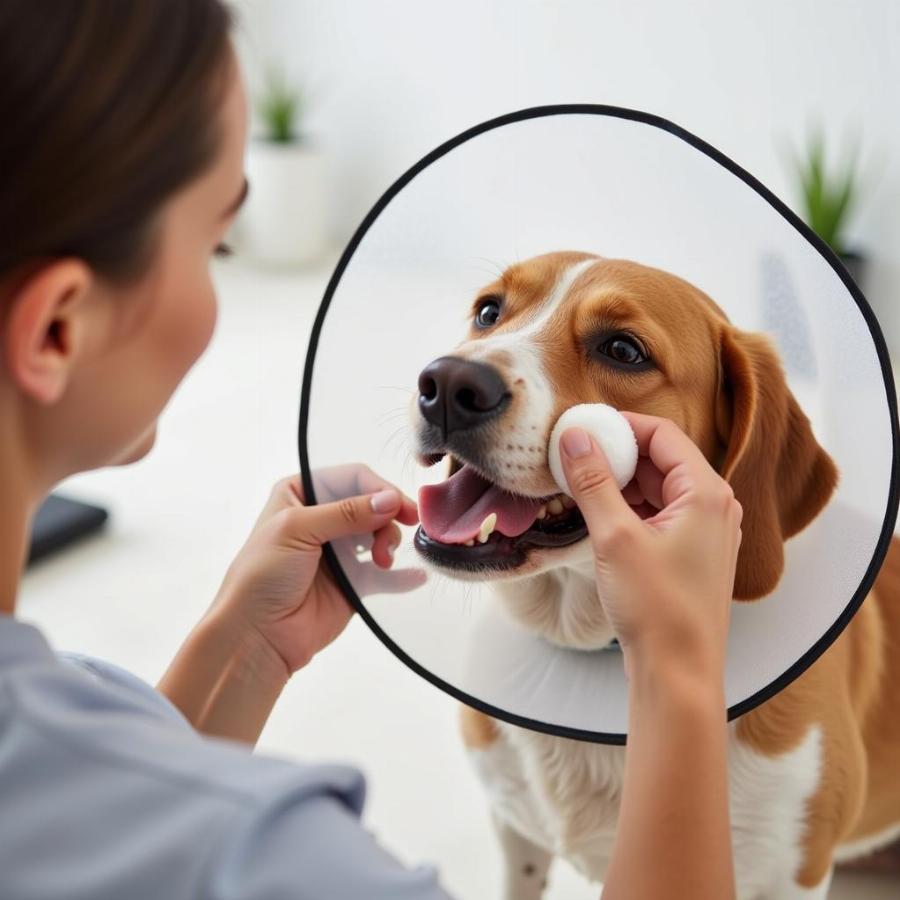A ruptured eardrum, also known as a tympanic membrane perforation, is a serious condition that can affect dogs. It can cause pain, hearing loss, and even infections. Understanding the causes, symptoms, and treatment options for a burst eardrum in dogs is crucial for any responsible pet owner. This comprehensive guide will provide you with everything you need to know about this condition, empowering you to provide the best possible care for your canine companion.
Recognizing the Signs of a Burst Eardrum in Your Dog
Identifying a burst eardrum in dogs can be tricky, as they can’t tell us what’s wrong. However, certain behavioral and physical signs can indicate this painful condition. If your dog exhibits any of these symptoms, it’s essential to seek veterinary attention immediately. Some common signs include head shaking, pawing at the ear, tilting the head, discharge from the ear (which might be bloody or pus-filled), loss of balance, and facial paralysis. Changes in behavior, such as whining, whimpering, or general discomfort, can also suggest an ear problem.
Causes of Burst Eardrums in Dogs
Several factors can lead to a burst eardrum in dogs. Ear infections are a common culprit, as the inflammation and pressure buildup can rupture the delicate membrane. Trauma to the ear, such as a foreign object lodging in the ear canal, a sharp blow, or even excessive cleaning, can also cause a perforation. Loud noises, like explosions or fireworks, are another potential cause. Certain medical conditions, like tumors or polyps in the ear, can also contribute to this problem.
Diagnosing and Treating a Burst Eardrum
A veterinarian will diagnose a burst eardrum by examining your dog’s ear with an otoscope. This instrument allows them to visualize the eardrum and identify any perforations. Further tests, like bacterial cultures or imaging studies, might be necessary to determine the underlying cause and extent of the damage. Treatment varies depending on the cause and severity of the rupture. Medications, such as antibiotics or anti-inflammatories, are often prescribed to address infections and reduce pain. In some cases, surgery might be required to repair the eardrum or address underlying issues like tumors.
How can I prevent my dog from getting a burst eardrum?
Preventing a burst eardrum involves regular ear cleaning, prompt treatment of ear infections, and protecting your dog from loud noises and potential ear trauma.
What are the long-term effects of a burst eardrum in dogs?
While many dogs recover fully, some may experience partial or complete hearing loss in the affected ear. Chronic ear infections can also be a long-term complication.
Caring for a Dog with a Burst Eardrum
During the healing process, it’s essential to keep the affected ear clean and dry. Your veterinarian will likely recommend avoiding swimming or bathing. Follow their instructions regarding medication administration and follow-up appointments. Patience is key, as it can take several weeks or even months for a burst eardrum to heal completely.
 Caring for a Dog with a Burst Eardrum
Caring for a Dog with a Burst Eardrum
Conclusion
A burst eardrum in dogs is a serious condition that requires prompt veterinary attention. By understanding the causes, symptoms, and treatment options, you can be prepared to provide the best possible care for your furry friend. Early diagnosis and treatment are crucial for preventing complications and ensuring a full recovery.
FAQ
-
What does a burst eardrum look like in a dog? It’s not usually visible without specialized equipment. Your vet will use an otoscope to see the tear.
-
Can a dog’s eardrum heal on its own? Small ruptures may heal on their own, but larger tears often require medical intervention.
-
How long does it take for a dog’s eardrum to heal? Healing time varies, but it can take several weeks or months.
-
Will my dog be in pain? Yes, a burst eardrum is painful. Your vet will prescribe medication to manage the pain.
-
Can a dog live a normal life with a burst eardrum? Many dogs recover fully, but some may experience hearing loss in the affected ear.
-
What are the signs of an ear infection in a dog? Head shaking, scratching at the ear, redness, swelling, and discharge are common signs.
-
How often should I clean my dog’s ears? Consult your vet for recommendations based on your dog’s breed and individual needs.